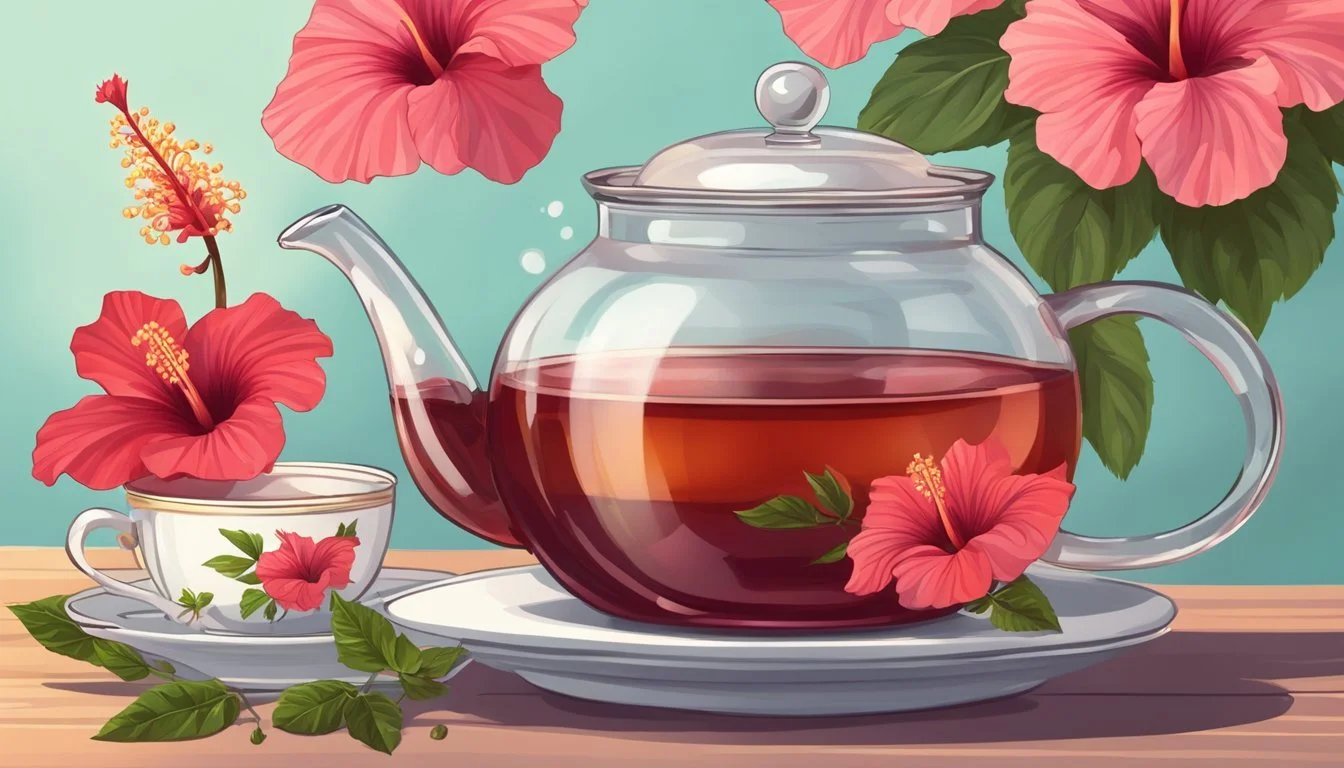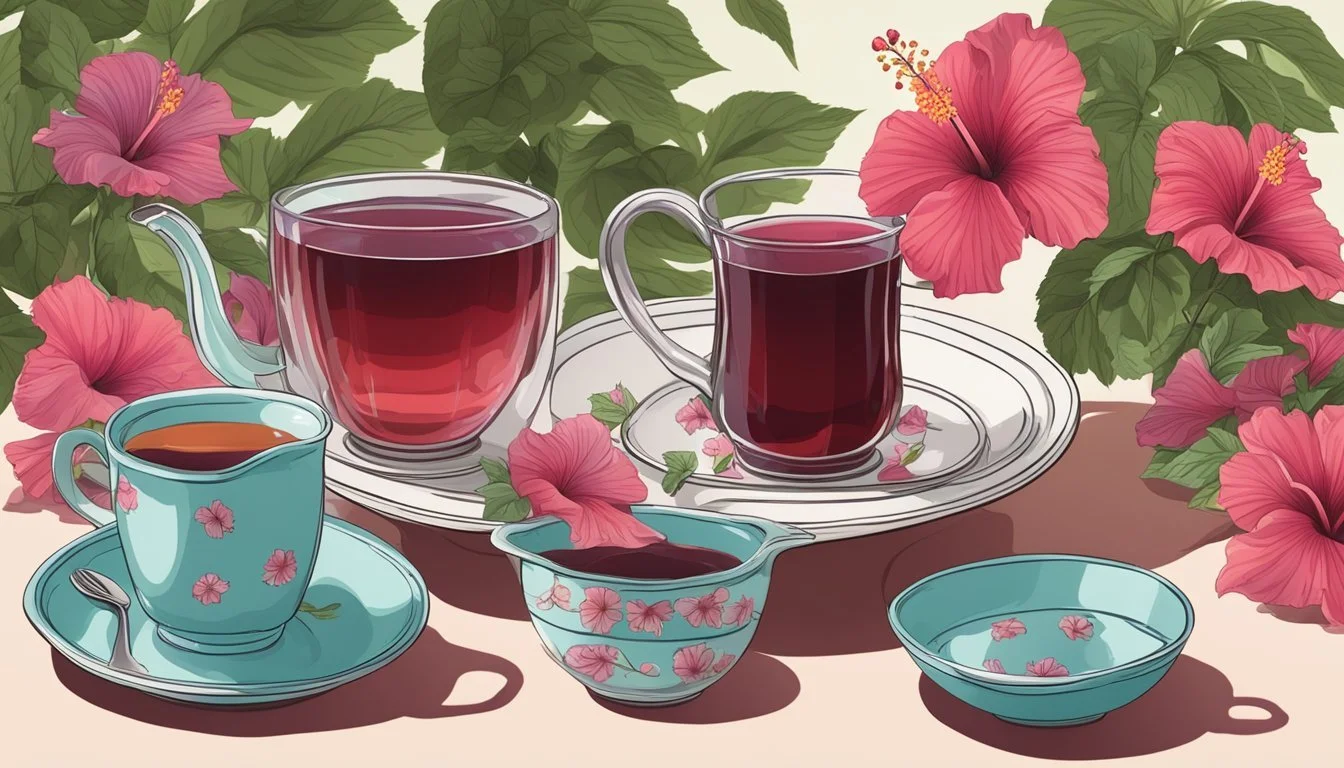How to Cook with Hibiscus
Mastering Floral Teas and Syrups
Cooking with hibiscus not only infuses dishes with a vibrant, crimson hue but also imparts a unique floral tartness that is both refreshing and versatile. Hibiscus flowers are an underutilized ingredient that can transform simple teas and syrups into intriguing culinary creations. In particular, the calyces—the part of hibiscus flowers just behind the petals—have found their place in the culinary world. They are commonly dried and used to make zesty teas and flavorful syrups that complement a myriad of beverages and desserts.
The process of making hibiscus tea involves steeping the dried calyces in hot water, resulting in a tart infusion known for its deep red color and potential health benefits. Similarly, crafting hibiscus simple syrup requires simmering these flavorful blossoms with sugar and water, a method that extracts their essence to produce a versatile sweetener.
In the preparation of both hibiscus tea and simple syrup, attention to detail in the steeping and simmering phases is key to achieving the desired intensity of flavor. These floral concoctions serve as an excellent base for experimenting with other ingredients, allowing both professional chefs and home cooks to explore the boundaries of taste and presentation in their culinary ventures.
Discovering Hibiscus
The section unveils the hibiscus, a plant teeming with nutritional values including vitamin C, calcium, iron, and antioxidants. It resides mainly in tropical regions and is renowned for its health benefits.
Hibiscus Plant Basics
The hibiscus flower, part of a diverse genus comprising hundreds of species, thrives primarily in tropical climates. Although it produces a variety of parts such as seeds, leaves, and petals, the most utilized are the calyces, the part behind the petals which is typically steeped to make hibiscus tea. Recognizable for its vibrant, often deep crimson blooms, the hibiscus is not only an ornamental beauty but a nutritional powerhouse as well.
Nutrition Profile of Hibiscus:
Vitamin C: An essential nutrient known for supporting the immune system.
Calcium: Vital for bone health and muscular function.
Iron: Crucial for oxygen transportation in the bloodstream.
Antioxidants: Hibiscus is rich in antioxidants that protect against cellular damage.
Benefits of Hibiscus
Hibiscus offers several health advantages, leveraged from its rich nutritional composition. The antioxidants present in hibiscus can combat oxidative stress and may aid in lowering high blood pressure. Its vitamin C content is beneficial for immune defense, while the minerals like calcium and iron support bone density and blood health respectively. As an infusion, hibiscus tea is often enjoyed for its potential to promote overall health and wellness.
Preparing Hibiscus Ingredients
When cooking with hibiscus, one must ensure that they begin with quality ingredients, whether choosing to use fresh or dried flowers. This section will guide readers through the selection process and the different applications of both dried and fresh hibiscus in culinary preparations.
Selecting Quality Hibiscus Flowers
To ensure the best flavor and efficacy in your floral teas and syrups, it is critical to start with high-quality hibiscus flowers. One should look for vibrant color and intact petals; these are signs of freshness and proper handling. Organic hibiscus flowers are often recommended to avoid pesticides and chemicals. These can be sourced from specialty health food stores or well-stocked grocery stores with an emphasis on natural products.
When purchasing, consider:
Color: Deep, ruby red color indicates freshness.
Texture: Petals should be firm and not overly brittle.
Aroma: Flowers should have a mildly tart and pleasant scent.
Using Dried vs Fresh Hibiscus
Dried Hibiscus Flowers are more commonly available and offer convenience for storage and consistent quality. They should be stored in a cool, dark place to maintain their deep crimson color and tart flavor. When preparing tea or syrup, dried flowers are steeped in hot water, which extracts their vibrant color and tangy flavor.
Fresh Hibiscus Flowers require more careful handling. The green parts and the center of the flowers must be discarded, using only the calyces and petals. Fresh hibiscus can provide a brighter, more delicate flavor profile but are less commonly found in grocery stores.
Here are the best practices for using each type:
Criteria Dried Hibiscus Fresh Hibiscus Availability Year-round at grocery stores Seasonal and location-dependent Preparation Steeping in hot water Removing unwanted parts before use Storage In an airtight container away from light Refrigerated and used quickly
When preparing syrups, the dried variety is generally preferred for its concentrated flavor.
Making Hibiscus Tea
The process of making hibiscus tea involves specific techniques to steep the dried flowers in hot water for optimal flavor extraction or cold-brewing for a more mellow taste typically served as cold drinks such as iced tea.
Steeping the Perfect Cup
To steep hibiscus tea, one begins by boiling 1 1/2 cups of water for every tablespoon of dried hibiscus flowers. Once the water reaches a rolling boil, the heat is turned off, and the dried hibiscus flowers are added into the pot. The mixture is then covered and let to steep for 15-20 minutes. The longer one allows the tea to steep, the more intense the flavor and color will be. After steeping, the tea is strained to remove the flowers and can be sweetened with sugar to taste.
Water Temperature: Just off the boil (about 208°F)
Steeping Time: 15-20 minutes
Sweetener (optional): Add sugar while the tea is still warm for better dissolution.
Cold-Brewing Techniques
Cold-brewing hibiscus tea is a different method that results in a less tart flavor profile ideal for iced tea preparations. To cold-brew, one places dried hibiscus flowers in a jar or pitcher and fills it with cold water at a ratio of one tablespoon of flowers per cup of water. The mixture is stirred and then placed in the refrigerator to steep for at least 20 minutes but can be left overnight for deeper flavor and richer color. Once the desired strength is reached, the tea is strained to discard the flowers.
Water Temperature: Cold
Steeping Time: At least 20 minutes to overnight
Serving Suggestion: Serve over ice for a refreshing cold drink.
For both methods, hibiscus tea bags can be used instead of loose flowers for convenience. The tea offers versatility and can be enjoyed hot or cold, ensuring it suits various preferences and occasions.
Crafting Hibiscus Simple Syrups
Creating hibiscus simple syrup involves simmering the flowers with sugar and water until the sweetness of the sugar is infused with the tangy floral flavor of hibiscus.
Classic Hibiscus Simple Syrup Recipe
Ingredients:
Water: 1 cup
Granulated sugar: 1 cup
Dried hibiscus flowers: 1/2 cup
Instructions:
Combine the sugar and water in a saucepan over medium heat. Stir until the sugar has fully dissolved.
Add the hibiscus flowers to the mixture and bring to a boil.
Reduce heat and simmer for 10 minutes, allowing the hibiscus to steep and infuse its flavor.
Strain the mixture using a fine wire-mesh strainer to remove all the hibiscus solids.
Cool the syrup at room temperature. Then transfer to a mason jar or airtight container and refrigerate. The syrup should be used within 2 to 3 weeks.
Variations and Flavored Syrups
To enhance the flavor profile of a classic hibiscus simple syrup, additional ingredients can be introduced to complement the hibiscus notes.
Suggestions for Variations:
Citrus: Add the zest of one lemon or orange during simmering for a citrus twist.
Herbs: Incorporate herbs such as mint or rosemary for an aromatic complexity.
Spices: Introduce spices like cinnamon sticks or vanilla pods for warm undertones.
Each variation follows a similar method to the classic hibiscus simple syrup recipe, with the added elements included during the simmering process. Experimenting with various ingredients can yield a homemade simple syrup recipe that suits a variety of beverages and desserts.
Incorporating Hibiscus in Beverages
Hibiscus flowers offer a distinct tart flavor and deep crimson color, making them a unique and visually appealing addition to numerous beverages, from refreshing teas to vibrant cocktails.
Enhancing Teas and Lemonades
Hibiscus teas and lemonades benefit from the natural tartness and rich color of hibiscus. To prepare hibiscus tea, one can steep dried hibiscus flowers in boiling water. This not only imparts a deep floral flavor but also infuses the tea with beneficial antioxidants and vitamin C. The addition of citrus, such as lemon or lime juice, complements the tartness of the hibiscus and can enhance its refreshing qualities. For a twist on traditional lemonade, incorporating hibiscus syrup or steeped hibiscus flowers can yield a delightful pink lemonade with complex floral notes.
Hibiscus Tea Recipe
Steep dried hibiscus flowers in hot water for 5 minutes.
Strain and serve hot or over ice with a slice of lemon.
Hibiscus Lemonade Recipe
Prepare hibiscus tea as above and cool.
Mix with equal parts lemonade and serve chilled with ice.
Crafting Cocktails and Mocktails
When it comes to cocktails like a hibiscus margarita or hibiscus rum punch, hibiscus syrup is a versatile ingredient. It can replace grenadine for its similar color and complementary tartness but with lesser calories. Cocktail enthusiasts can create hibiscus-infused liquors by steeping dried flowers in spirits such as rum or vodka to craft unique floral cocktails. Similarly, for hibiscus mocktails, the syrup can be mixed with soda water to create a hibiscus soda, or with lime juice and ginger for a non-alcoholic hibiscus mojito. For a sophisticated frozen treat, hibiscus sorbet made with hibiscus syrup can be added to drinks, creating bold floral flavors and enticing pink cocktails with a touch of whimsy.
Hibiscus Margarita Recipe
Combine hibiscus syrup, tequila, lime juice, and ice in a shaker.
Shake and strain into a glass rimmed with salt.
Hibiscus Mocktail Recipe
Mix hibiscus syrup with lime juice, muddled mint, and ginger ale.
Serve over ice garnished with a sprig of mint.
Savory and Sweet Culinary Uses
The hibiscus plant offers a unique tartness that enhances both savory and sweet dishes. Its vibrant crimson color and cranberry-like flavor make it a versatile ingredient in cooking.
Hibiscus-Infused Sauces and Syrups
Incorporating hibiscus into sauces and syrups adds a distinct tartness and a pop of color that can elevate various dishes. A simple hibiscus syrup can be prepared by simmering hibiscus flowers with sugar and water, optionally adding flavors such as orange zest, vanilla bean, or lemongrass. This syrup can be drizzled over pancakes or used to sweeten iced tea. In savory applications, a hibiscus glaze containing agave and garlic pairs well with Jamaican jerk-seasoned meats, delivering a sweet, tangy, and earthy profile.
Desserts and Baking with Hibiscus
The tartness of hibiscus is a delightful counterpart in sweet treats, from ice cream to cakes. Hibiscus flowers can be ground into a fine powder and mixed into batter for a floral twist or used as a garnish for a burst of color. An interesting recipe to try is hibiscus pavlova, which combines the floral notes of hibiscus with the sweetness of meringue and cream. For a playful take on a classic drink, add hibiscus to a Shirley Temple by mixing hibiscus syrup with sparkling water, a splash of orange juice, and garnishing it with raspberry and mint.
Social Media and Presentation Tips
When presenting hibiscus-infused teas and syrups, one's focus should be on vibrant visuals and engaging content that highlights the unique qualities of hibiscus as a culinary ingredient.
Creating Instagram-Worthy Hibiscus Creations
On Instagram, the allure is all about the visuals. For hibiscus margaritas and cocktails, use:
Bold colors: The deep crimson of hibiscus is your visual star.
Clear glassware: To showcase the drink’s vibrant color.
Natural light: Enhances the clarity and sparkle of your beverages.
Garnishes: A hibiscus petal on the rim or a twist of citrus elevates the presentation.
Tip: Boomerangs of pouring the hibiscus syrup into drinks can capture movement and pique interest.
Sharing Your Creations on Pinterest and Facebook
For Pinterest and Facebook:
Step-by-step images: Share the process of creating hibiscus syrups or adding them into favorite drinks.
Descriptions: Offer detailed notes on the flavor profiles and any pairing suggestions.
Hashtags: Use relevant tags like #HibiscusSyrup or #FloralCocktails to increase visibility.
DIY Guides: Post recipes for making simple syrup with a hibiscus twist to encourage engagement.
Capture the essence of hibiscus by focusing on the rich color and the unique tartness it brings to beverages.
Storing and Preserving Hibiscus Products
When it comes to preserving the vibrant flavor and color of hibiscus products, proper storage techniques are crucial. Implementing effective methods can significantly extend the shelf life of hibiscus teas and syrups, ensuring they maintain their quality over an extended period.
Extending Shelf Life in the Refrigerator
For hibiscus syrup and hibiscus simple syrup, cooling is key to longevity. These syrups should be stored in the refrigerator immediately after cooling to room temperature. Employing this practice can help retain the syrups' freshness and prevent spoilage. It's recommended to use glass jars, such as mason jars, which offer an airtight seal to minimize exposure to air. Here's how one should store the syrups:
Transfer the syrup into a clean, dry glass jar.
Seal the jar tightly with a lid to keep out contaminants.
Label the jar with the date of storage to track its shelf life.
The refrigerator extends the life of hibiscus syrups significantly, but one should use them within 4 weeks to enjoy their full flavor profile.
Proper Use of Strainers and Jars
When preparing hibiscus tea for later use, straining all the solids out is crucial for a clear, sediment-free final product. A fine mesh strainer proves invaluable in this step. The tea should be carefully poured through the strainer into a glass jar to ensure no flower residue is left. To store the liquid properly:
Allow the strained tea to cool completely.
Decant the tea into a glass jar, filtering once more if necessary.
Make sure the jar is sealed tightly before refrigerating.
These storage practices help maintain both the integrity of the tea's flavor and its health benefits. Stored correctly, hibiscus flower tea can be refrigerated for up to a week.
Health Considerations and Nutritional Information
When incorporating hibiscus into teas and syrups, understanding its nutritional profile and health implications is crucial. Key factors include the calorie content associated with various sweeteners and hibiscus' notable effects on blood pressure.
Calories and Sweeteners in Hibiscus Drinks
Hibiscus itself is low in calories, but the addition of sweeteners can change its caloric content significantly. Here's a breakdown:
Hibiscus tea: Almost negligible calories
Sugar: 16 calories per teaspoon (4.2 grams)
Honey: 21 calories per teaspoon (7 grams)
Choosing a sweetener for hibiscus tea or syrup involves balancing flavor preferences with dietary considerations. When sweetening hibiscus beverages, natural options like honey add more than sweetness; they contribute small amounts of nutrients and antioxidants. However, they must be used in moderation due to their high caloric density.
Hibiscus' Impact on Blood Pressure
Numerous studies suggest hibiscus tea's role in lowering blood pressure:
Routine Consumption: May lower systolic and diastolic blood pressure
Antioxidants: High levels, including flavonoids, which contribute to health benefits
Hibiscus contains vitamin C and minerals that support the overall cardiovascular system. Individuals with high blood pressure may find hibiscus tea a beneficial addition to their diet due to these properties, though it should not replace prescribed treatments. Always consult with a healthcare provider before making significant changes to health routines.






